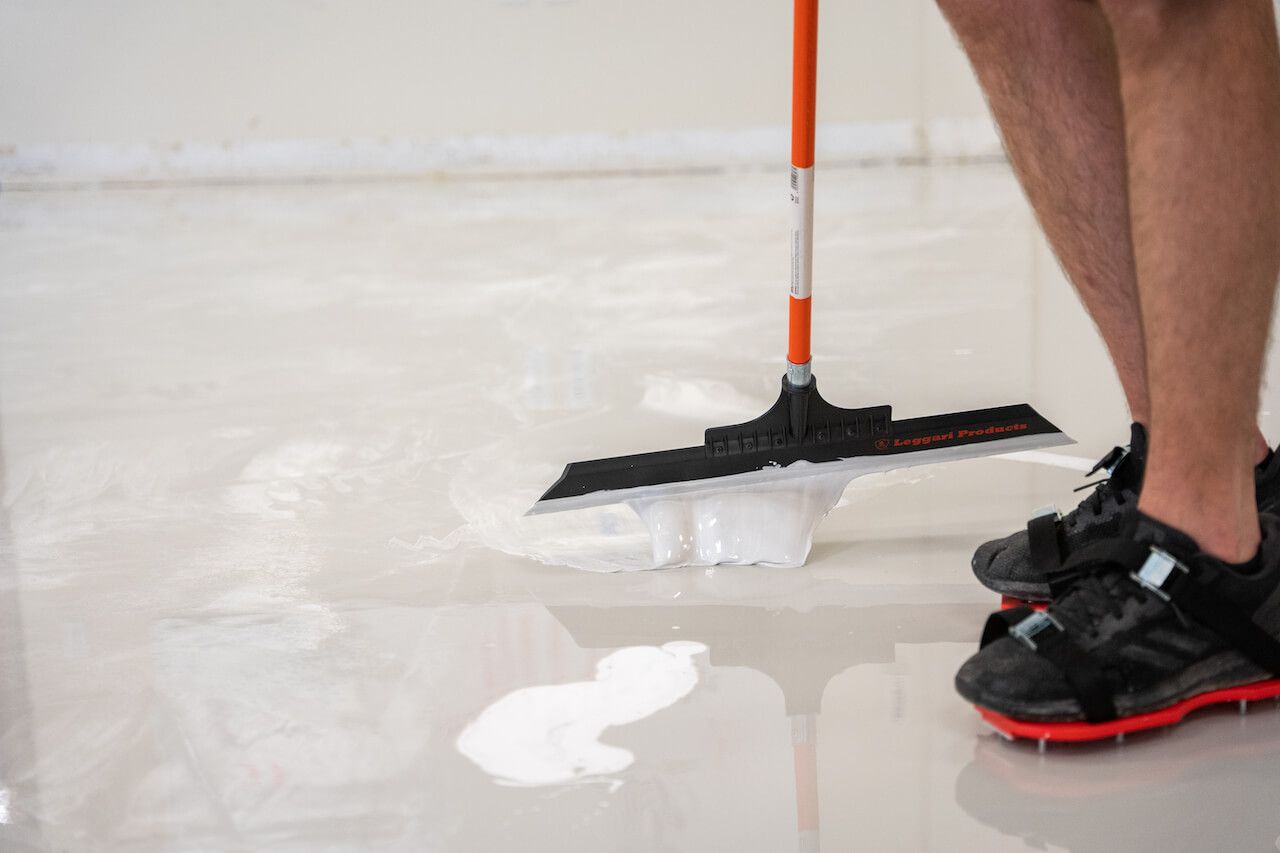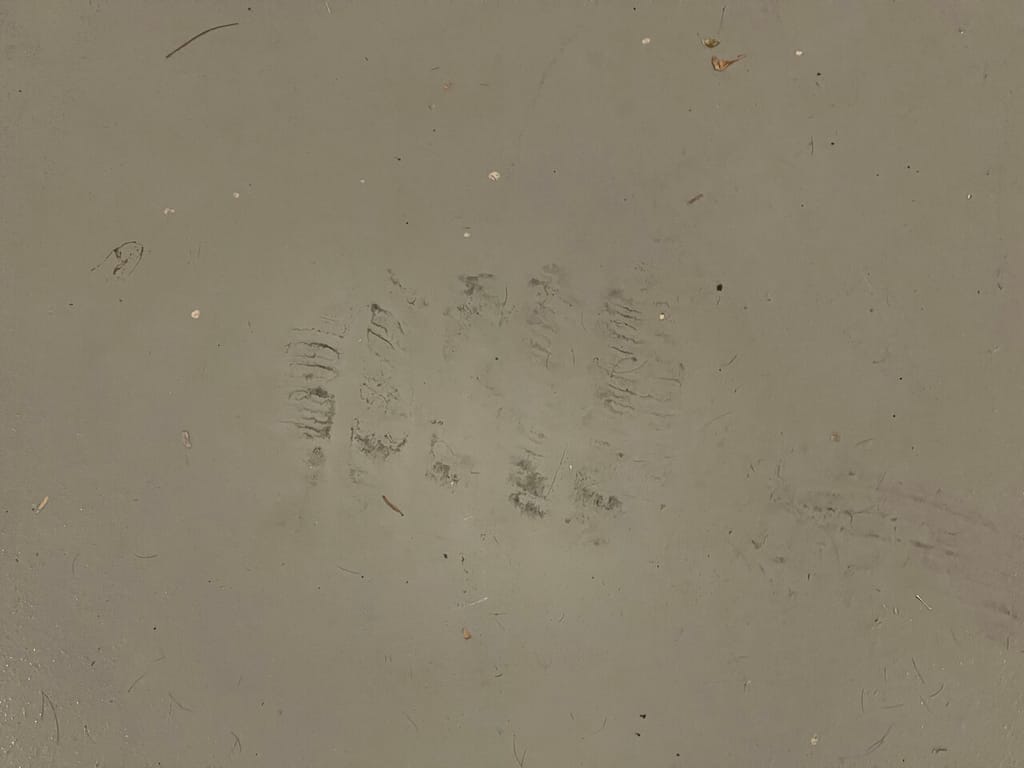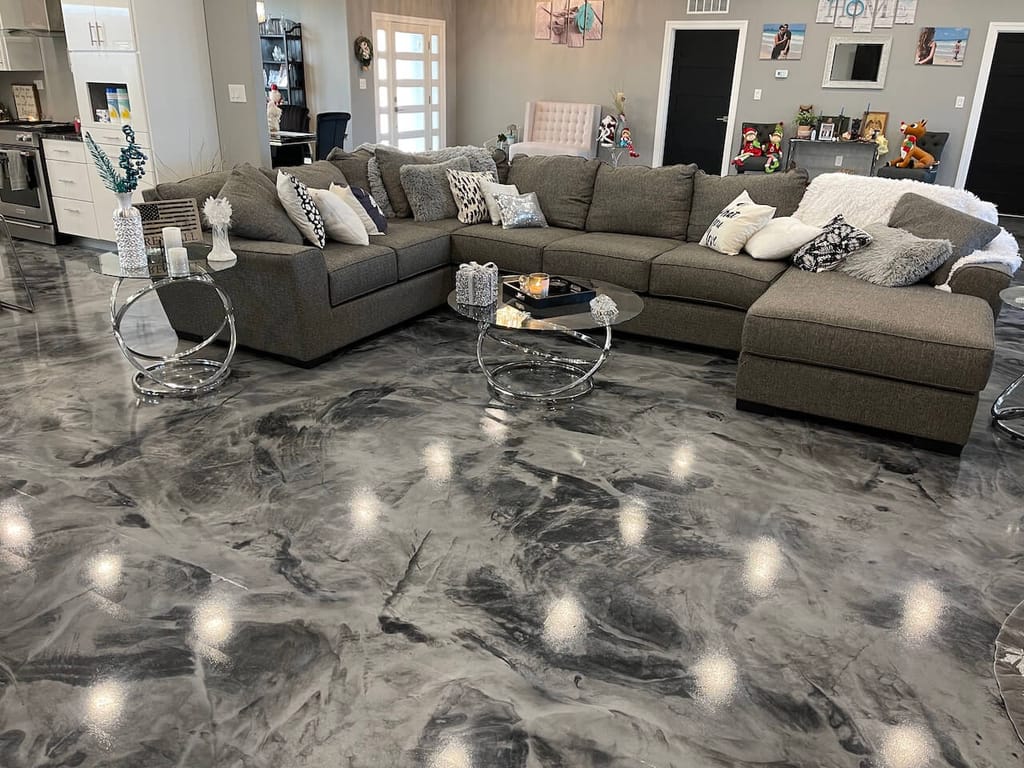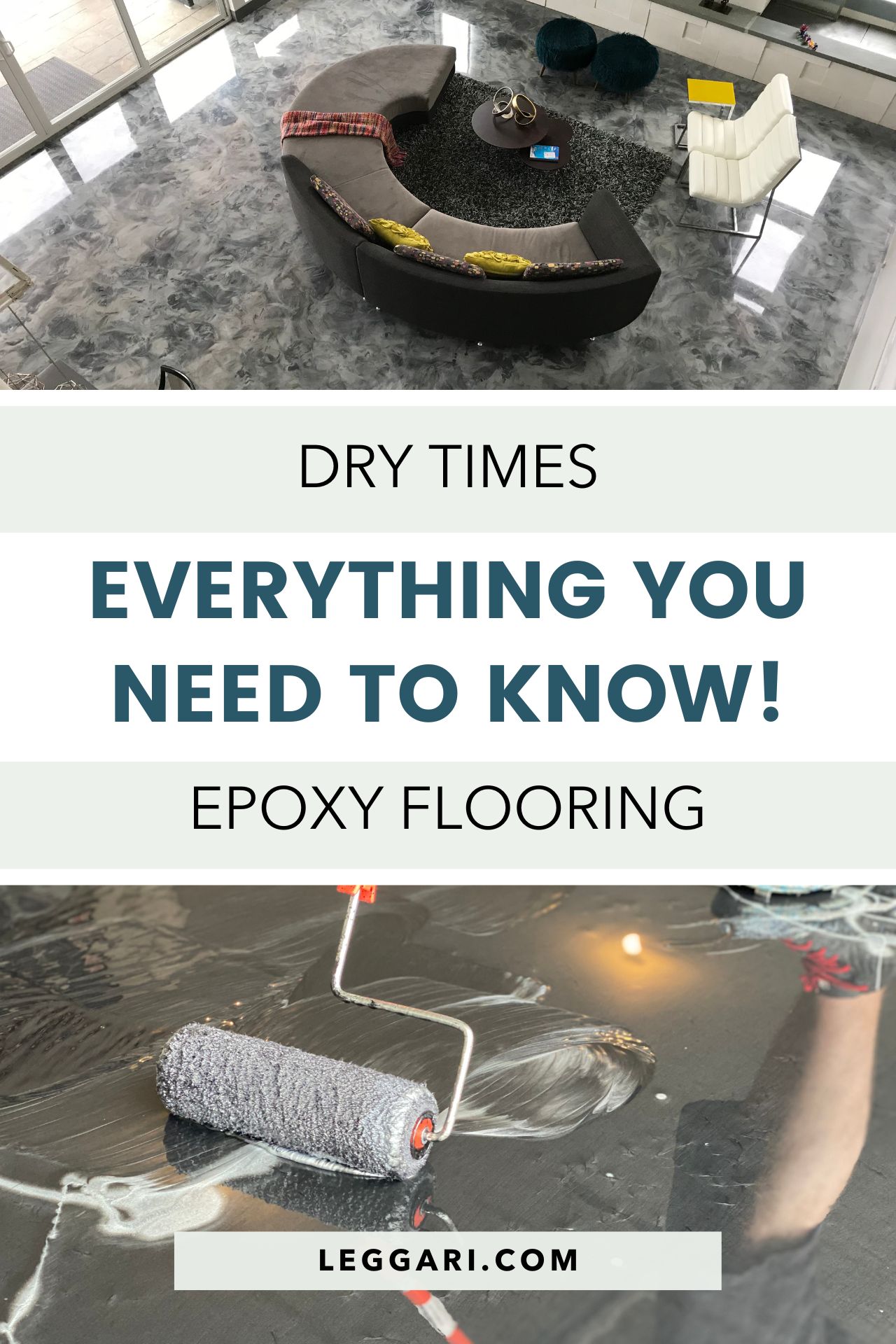If you’re considering installing epoxy flooring in your home, it’s important to know how long the full installation process will take and when you can start using the space again.
In this blog post, we’ll discuss the different factors that can affect the epoxy flooring dry time, as well as give you an idea of what to expect in terms of wait time. We will also give you some tips and tricks to help your epoxy floors dry faster. Finally, we provide some tips on keeping your new floors looking great for years to come!
What is epoxy flooring and how does it work?
Epoxy flooring is a type of flooring that uses a resin coating to create a durable, long-lasting surface.
Epoxy floors were originally found in industrial and commercial settings, where they were able to withstand heavy traffic and use. But today, homeowners, DIY’ers, and contractors are installing these high-performance floor coatings in their homes and garage floors.
Epoxy floors are made by combining a resin and a hardener to create a strong, durable coating. The epoxy coating is then applied to the floor and allowed to cure, or harden.
Once the epoxy coating has reached its full, chemical-resistant cure, it creates a tough, resilient surface that is resistant to wear and tear, chemicals, and stains. Epoxy floors are easy to clean and maintain, making them an ideal choice for areas with heavy foot traffic (and even vehicle traffic), including households with kids and pets.

How long does epoxy flooring take to dry fully?
It is important to note that curing is not the same as drying. Curing is a chemical process that occurs as the epoxy resin and hardener react with each other to form a strong, durable bond. Drying, on the other hand, simply refers to the evaporation of solvents from the epoxy mixture.
While your epoxy floors may be dry to the touch after 24 hours, it will take additional time for the new floor to cure completely.
The curing time of an epoxy floor can vary depending on the thickness of the epoxy coating, the temperature, and the humidity of the curing environment. It generally takes about 24 to 72 hours for the epoxy floors to dry completely. After 3 days you should be able to apply light foot traffic, for instance, if you need to use the space to access other areas in your home. But, if it can be avoided, it is best to wait for the full chemical-resistant cure.
Note that while you should be able to walk on the floor after 72 hours, the full cure time can take up to 28 days (though many floors do cure faster - typically within about seven days).
It is very important to understand that epoxy flooring will not be completely dry until it has had enough time to cure fully. This means that you should avoid putting heavy furniture or appliances on any new epoxy coatings until the full cure is complete. Otherwise, you run the risk of damaging the new floors.
Once the entire process is complete, your floor will be ready to withstand heavy traffic and abusive conditions. So, if you’re looking for a long-lasting and tough flooring solution, be sure to consider epoxy.
How long does it take for an epoxy floor coating to dry?
As we mentioned above, there is a notable difference between epoxy floor curing times and dry times. Typically epoxy coatings will be dry to the touch (but often still tacky) after 24 hours. At this stage, you want to avoid stepping on the coating or doing anything else that could lead to a surface imperfection.
Typically, the final top coat will be dry in 3 days and can accept foot traffic such as entering and exiting the room with no problem, but if it is avoided altogether, then this would be best.
It is important to note that the epoxy floors will not be fully cured until the seven-day mark, perhaps even longer. During this time, it is important to avoid exposing the surface to heavy traffic, furniture, or chemicals.

Epoxy Resin vs Epoxy Paint
Epoxy resin and epoxy paint are both popular choices for garage floor coatings but these epoxy coatings are far from the same. While the epoxy resin is much stronger and more durable than epoxy paint, today we’re interested in how they compare in terms of drying time?
Epoxy resin is a two-part system that starts with a base coat and is then topped with a clear coat. The base coat typically takes 24 hours to dry, while the clear coat can take up to 72 hours.
This means that epoxy resin takes longer to dry than garage floor paint. However, epoxy resin creates a much more durable epoxy floor coating and is much more durable and resistant to chipping and peeling. It also has the option of a high gloss epoxy clear coat finish that epoxy paint cannot match. So if you’re looking for the longest-lasting and most durable garage floor coating, epoxy resin is the way to go.
A Note on Garage Floor Epoxy vs Garage Floor Paint
When it comes to garage flooring, there are two main types of products: garage floor epoxy and garage floor paint. On the surface, these products look very similar but they are very different. It’s important to choose the right one for your needs.
While garage floor paint may be a less expensive option, it’s not nearly as durable as epoxy. It’s also more susceptible to staining and fading over time.
Garage floor epoxy is a popular choice because it’s extremely durable and easy to clean – much better than garage floor paint. It also comes in a variety of colors instead of just the old boring gray. You can even take it a step further and go with a flake floor system. The flakes are applied in the first coat of epoxy and then covered with a final top coat.
However, these can be more expensive than garage floor paint and will require a longer curing time.
So, which is the better option for your garage? That depends on your budget and your needs, but we would have a hard time recommending ANYONE go with epoxy paint or garage floor paint on their garage floor. This type of coating will not withstand a lot of vehicle traffic and is susceptible to hot tire pickup.
The little money saved upfront won’t be worth the headaches you’ll be forced to endure down the line.

Epoxy Flooring Dry Time – Garage Floor vs Basement Floor
Garage floors and basement floors are two of the most common surfaces that people apply epoxy to. And, while the garage floor is typically subject to more wear and tear than the basement floor, both surfaces need to be given adequate time for the epoxy coatings to dry and cure after the application process before resuming use.
Applying epoxy to a garage floor vs. a basement floor can affect drying time due to the room temperature and floor temperature. To ensure your product sets up within the correct times, the installation should be done when room temperatures are between 55° and 75° Fahrenheit.
In warmer regions, or when installing during the summer months, the room temperature in a garage is usually hotter than in a basement which can help the epoxy resin dry faster.
High humidity or relative humidity can also affect drying time. If the room is more humid, it will take longer for the epoxy to dry. However, if the floor is more humid, it could cause it to dry faster because the humidity is evaporating quicker. All of these factors can affect how long it takes for the epoxy resin to dry completely.
How long before you can walk on a new epoxy floor?
As we mentioned above, there is a big difference between a new epoxy floor that can handle some light foot traffic versus a floor that has been allowed to cure completely.
Can I walk on epoxy after 72 hours? That’s a question we get a lot here at Leggari. Well, the answer is…it depends.
Generally, our epoxy product can accept foot traffic 72 hours after it has been applied. However, most epoxies will not have reached their full hardness for 7 days. We recommend waiting the full 7 days before subjecting your new floor to heavy foot traffic or furniture.
If you do put furniture on your epoxy floor too soon, you risk leaving an indent or surface imperfection in the epoxy. Those indents can be difficult, and sometimes impossible, to remove. So, while you can technically walk on epoxy 3 days after it’s been applied, we recommend waiting until the full cure time before putting any heavy stress on the floor.

More Questions on the Epoxy Flooring Curing Process
Every day here at Leggari, we get dozens (or even hundreds) of questions about our high-performance floor coatings, and our team of helpful and qualified installation technicians are able to steer current and would-be customers in the right direction.
We’ve compiled a list of the most frequently asked questions we get about our epoxy coatings curing times and how long it takes for them to dry completely. If you have any other questions, feel free to reach out to us and we’ll be happy to help!
How long does it take for epoxy to cure in cold weather?
It can take considerably longer for epoxy to cure in cold weather than in warmer conditions. The ideal temperature range for curing epoxy is between 55 and 75 degrees Fahrenheit. Though it can still cure at cooler temperatures if given enough time, we recommend performing the application process when temps are within this range.
In general, you can expect epoxy to take twice as long to cure in cooler temperatures as it would in warm weather conditions. So if your epoxy would normally take 7 days to cure at 75 degrees Fahrenheit, it could take up to several weeks to cure when the temperature drops to 50 degrees Fahrenheit.
If you’re working with epoxy in cold weather conditions, you’ll need to be patient and give it the time it needs to fully cure. Depending on the type of epoxy you’re using and the temperature, this could mean waiting several additional days before the project is complete.
The bottom line is that the curing time will be longer. However, the end result will be worth the wait!
What are some common installation mistakes that can cause the dry time of your epoxy floor to be extended unnecessarily?
One of the most common installation mistakes that can cause the dry time of your epoxy floor to be extended unnecessarily is applying a thicker coat than recommended. This might seem like it would be a good thing because it will protect your floor better, but it is actually not necessary and will only extend the dry time. While it may seem like this would make the floor more durable, it actually just makes it more difficult for the epoxy to cure properly.
In addition, using a heat lamp to speed up the curing process can also cause problems. The heat can cause the epoxy to bubble and blister, which will extend the dry time. Heat lamps can cause the epoxy to skin over too quickly, which may trap bubbles, causing surface imperfections, and making the epoxy take longer to cure.

How can you make sure your epoxy floor dries as quickly as possible so you can start enjoying it sooner rather than later?
If you’re anxious to start enjoying your new floor ASAP, there are a few things you can do to help the drying process along.
First, it’s important to create a warm environment – epoxy cures best at temperatures between 55 and 75 degrees Fahrenheit. If it’s too cold, the curing process will take much longer.
Another way to ensure that your floor dries quickly is by using a forced-air heater. This will help to circulate the air and speed up the drying process.
Note: we don't recommend using a heat gun for this process.
You should also make sure that the room is well-ventilated so that the fumes from the epoxy products can escape.
Finally, you should keep the temperature in the room as warm as possible to accelerate the drying time. With these tips, your epoxy floor should be dry in no time!
Can you speed up the epoxy curing process?
There are many factors that can affect the cure time of epoxy, such as room temperature, humidity, and the type of epoxy you are using. However, there are a few things you can do to speed up the process.
One way to speed this up is to increase the temperature to the higher end of the installation range. This will cause the epoxy to cure faster because the molecules will be moving around more quickly. Make sure that the ambient temperature is above 55 degrees Fahrenheit, as epoxy will not properly cure below this temperature.
You can also use an epoxy accelerator to speed up curing any time a faster cure is needed or if you are installing in a cold environment.

How can you tell if the epoxy flooring has fully dried and is ready for use?
One of the most important factors to consider when installing your flooring is the cure time. This is the amount of time it takes for the coating to fully harden and set. Depending on the type of epoxy being used, the dry time can range from 24 hours to 3 days.
However, just because the epoxy has hardened does not mean that it is ready for use. The flooring needs to cure before it can be used. Epoxy floor curing times can vary but typically this process usually takes about 7 days, sometimes longer.
During this time, the flooring will harden and set completely. Once the full cure is complete, the flooring will be as strong as it is going to get and will be able to withstand heavy traffic.
Unfortunately, it is difficult to tell if the epoxy floors have fully dried. The best way to tell if the flooring is ready for use is to wait at least seven days after installation before using the room. This will give the flooring plenty of time to completely dry.
Can I walk on epoxy after 12 hours?
When you are coating your floor with epoxy, you might be wondering how long you have to wait until it is safe to walk on the surface. The short answer is that you should not walk on epoxy until it is fully cured, which can take up to seven days.
While the floor may be dry to the touch and can technically withstand light foot traffic after 12 hours, this does not mean that the epoxy will be dry enough to walk on. In fact, it takes several days for the top coat to reach a stage where it is safe to handle any foot traffic. During this time, the final top coat will continue to harden and become more resilient. As a result, it is important to avoid placing any heavy objects on the floor during this period. Once the epoxy has fully cured, it will be much more durable and will be able to withstand heavy traffic.
How long before you can drive on an epoxy garage floor?
For those wondering how long they must wait before driving on an epoxy garage floor, the answer is typically 7 days.
However, it is important to note that this timeline can vary depending on a number of factors, such as the temperature and humidity levels in the garage.
It is always best to err on the side of caution and wait a full week before driving on an epoxy garage floor. This will give the flooring plenty of time to set and fully cure.
While epoxy flooring is a great investment for any home or business, it is important to understand the total time commitment before installation. By taking the time to understand the different factors that can affect the drying time, you can ensure that your epoxy floor looks great and lasts for years to come!
How long do I have to wait to epoxy new concrete?
One of the most frequently asked questions about epoxy flooring is how long to wait before applying it to new concrete.
The answer depends on a number of factors, including the age and cure of the concrete, the temperature and humidity conditions, and the type of epoxy being used.
In general, it is best to wait at least 28 days before applying epoxy to new concrete, though many would recommend waiting upwards of 45 days. This will give the concrete floors time to cure and harden, ensuring that the epoxy will adhere properly.
The floor should be completely dry before the epoxy is applied, so any necessary repairs should be made and the concrete should be allowed to dry completely. If the concrete has been previously sealed, it may be necessary to remove the sealant before applying the epoxy. This can often be done with a shot blaster or by using Leggari’s Prep Replacement.
With proper preparation, you can transform your concrete floors with epoxy and provide a durable and attractive finish that will last for years to come.
What should you do if you notice any problems with the epoxy flooring after it has been installed?
Once your epoxy floor has been installed, it is important to inspect it for any issues. Hopefully, the floor turned out exactly as you’d planned but if you notice any problems with the coating after it has been installed, the first step is to contact the installers or the company you purchased your floor from. They will be able to assess the situation and determine whether the floor can be repaired or if a new floor will need to be installed.
In most cases, the floor can be repaired without any major problems. However, if the floor is damaged beyond repair, it may have to be reinstalled. Either way, it is important to get in touch with the flooring company as soon as possible so that they can resolve the issue in a timely manner.
If you are using Leggari Epoxy or one of our Epoxy Floor Kits and have any questions along the way, please contact Leggari Customer Service and one of our knowledgeable installation technicians should be able to get your issues resolved quickly. We pride ourselves on providing great customer service, and we will do whatever it takes to make sure you are satisfied with your floor.
Can I apply epoxy myself?
Absolutely! Actually, we created our epoxy floor kits for this very purpose.
Many people choose to apply epoxy to their floors or countertops themselves in order to save money and get the exact look they want. Leggari Products was created out of necessity to provide individuals with the highest quality DIY products that make epoxy coating simple and easy. Applying epoxy is a straightforward process that does not require professional skills or experience. With Leggari’s step-by-step video tutorials, you can apply epoxy like a pro in just a few simple steps.
Leggari offers everything you need to get the job done right, including detailed instructions, high-quality tools, and top-of-the-line Leggari epoxy. With a little time and effort, you can achieve professional results without having to hire a contractor. Leggari’s DIY kits include everything you need from start to finish, and our easy-to-follow video tutorials make the process straightforward and foolproof.
Did we answer all of your questions?
Epoxy floors are a great choice for floors that need to be durable and resistant to chemical spills or other damage. It can also be very decorative, adding an attractive custom finish to your space.
In this post, we’ve answered some of the most common questions about epoxy flooring dry times – from how long it takes for epoxy to dry fully to when you can walk on it. We’ve also outlined the difference between epoxy resin and epoxy paint, as well as drying times for garage floors vs basement floors. If you have any additional questions about the installation, please don’t hesitate to reach out to us. And if you decide that epoxy flooring is right for your home or business, be sure to check out our epoxy floor kits. We hope you found this post helpful and that you are now ready to install your own Leggari epoxy floor!
